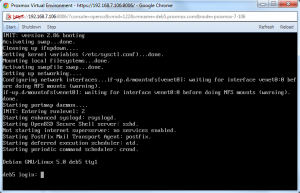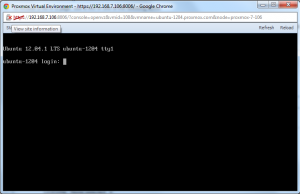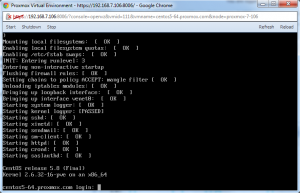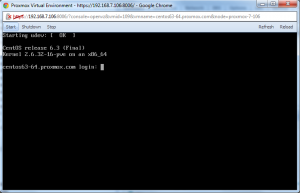OpenVZ Console: Difference between revisions
No edit summary |
|||
| Line 1: | Line 1: | ||
=Introduction= | == Introduction == | ||
Beginning with Proxmox VE 2.2, we introduced a new console view (with login capability). Especially for beginners it is not that easy to understand and manage containers but with the new console this is big step forward. OpenVZ and KVM console now look quite similar. | Beginning with Proxmox VE 2.2, we introduced a new console view (with login capability). Especially for beginners it is not that easy to understand and manage containers but with the new console this is big step forward. OpenVZ and KVM console now look quite similar. | ||
| Line 8: | Line 8: | ||
All Debian templates created with latest [[Debian Appliance Builder]] have already got this set of changes, just download them via GUI to your Proxmox VE storage (Debian 6 and 7 templates are up2date, 32 and 64 bit) | All Debian templates created with latest [[Debian Appliance Builder]] have already got this set of changes, just download them via GUI to your Proxmox VE storage (Debian 6 and 7 templates are up2date, 32 and 64 bit) | ||
= Debian 5,6,7 = | == Debian 5,6,7 == | ||
This will also work in debian8 if you use sysv-init instead of systemd | This will also work in debian8 if you use sysv-init instead of systemd | ||
== Editing the config file via the host == | === Editing the config file via the host === | ||
You can do this on the host without entering CT (but the CT must be running). Just log in to the Proxmox VE host and: | You can do this on the host without entering CT (but the CT must be running). Just log in to the Proxmox VE host and: | ||
| Line 22: | Line 22: | ||
</pre> | </pre> | ||
== Editing the configuration file inside the container == | === Editing the configuration file inside the container === | ||
[[Image:Screen-Debian-5-OpenVZ-console.png|thumb]] | [[Image:Screen-Debian-5-OpenVZ-console.png|thumb]] | ||
Login via SSH (or use the VNC "Shell") to your Proxmox VE host and 'vzctl enter CTID' the container: | Login via SSH (or use the VNC "Shell") to your Proxmox VE host and 'vzctl enter CTID' the container: | ||
| Line 47: | Line 47: | ||
Save the changes and shutdown/start the container via Console. | Save the changes and shutdown/start the container via Console. | ||
=Ubuntu= | == Ubuntu == | ||
== Ubuntu 10.04, 12.04, 14.04 == | === Ubuntu 10.04, 12.04, 14.04 === | ||
[[Image:Screen-Ubuntu-12.04-OpenVZ-console.png|thumb]] | [[Image:Screen-Ubuntu-12.04-OpenVZ-console.png|thumb]] | ||
Login via SSH (or use the VNC "Shell") to your Proxmox VE host and 'vzctl enter CTID' the container: | Login via SSH (or use the VNC "Shell") to your Proxmox VE host and 'vzctl enter CTID' the container: | ||
| Line 84: | Line 84: | ||
Save the changes and shutdown/start the container via Console. | Save the changes and shutdown/start the container via Console. | ||
=Centos= | == Centos == | ||
== Centos 5 == | === Centos 5 === | ||
[[Image:Screen-Centos-5-OpenVZ-console.png|thumb]] | [[Image:Screen-Centos-5-OpenVZ-console.png|thumb]] | ||
Login via SSH (or use the VNC "Shell") to your Proxmox VE host and 'vzctl enter CTID' the container: | Login via SSH (or use the VNC "Shell") to your Proxmox VE host and 'vzctl enter CTID' the container: | ||
| Line 109: | Line 109: | ||
Save the changes and shutdown/start the container via Console. | Save the changes and shutdown/start the container via Console. | ||
== Centos 6 == | === Centos 6 === | ||
[[Image:Screen-Centos-6-OpenVZ-console.png|thumb]] | [[Image:Screen-Centos-6-OpenVZ-console.png|thumb]] | ||
Login via SSH (or use the VNC "Shell") to your Proxmox VE host and 'vzctl enter CTID' the container: | Login via SSH (or use the VNC "Shell") to your Proxmox VE host and 'vzctl enter CTID' the container: | ||
| Line 142: | Line 142: | ||
Either run "start tty" without rebooting the container, or save the changes and shutdown/start the container via Console. | Either run "start tty" without rebooting the container, or save the changes and shutdown/start the container via Console. | ||
=Troubleshooting= | == Troubleshooting == | ||
If you still want to use the previous method (vzctl enter CTID) you can open the host "Shell" and just type 'vzctl enter CTID" to manage your containers. | If you still want to use the previous method (vzctl enter CTID) you can open the host "Shell" and just type 'vzctl enter CTID" to manage your containers. | ||
==Java browser plugin== | ==Java browser plugin== | ||
The console is using a Java applet, therefore you need latest Oracle (Sun) Java browser plugin installed and enabled in your browser (Google Chrome and Firefox preferred). If you are on Windows desktop, just go to java.com, if you run a Linux desktop you need to make sure that you run Oracle (Sun) Java plugin instead of the default openjdk. For Debian/Ubuntu based desktops, see [[Java_Console_(Ubuntu)]] | The console is using a Java applet, therefore you need latest Oracle (Sun) Java browser plugin installed and enabled in your browser (Google Chrome and Firefox preferred). If you are on Windows desktop, just go to java.com, if you run a Linux desktop you need to make sure that you run Oracle (Sun) Java plugin instead of the default openjdk. For Debian/Ubuntu based desktops, see [[Java_Console_(Ubuntu)]] | ||
= Modifying your templates = | == Modifying your templates == | ||
If you don't want to commit the changes above for every single CT you create, you can simply update the templates accordingly. For this, simply place the file you want to insert into your template (like etc/inittab for debian containers) into your template folder and update the template. | If you don't want to commit the changes above for every single CT you create, you can simply update the templates accordingly. For this, simply place the file you want to insert into your template (like etc/inittab for debian containers) into your template folder and update the template. | ||
| Line 174: | Line 174: | ||
rmdir -p etc/init</pre> | rmdir -p etc/init</pre> | ||
[[Category: HOWTO]][[Category: Technology]] | [[Category: HOWTO]] [[Category: Technology]] | ||
Revision as of 11:53, 27 October 2015
Introduction
Beginning with Proxmox VE 2.2, we introduced a new console view (with login capability). Especially for beginners it is not that easy to understand and manage containers but with the new console this is big step forward. OpenVZ and KVM console now look quite similar.
But as most OpenVZ templates have disabled terminals, you need to enable it first. This article describes the changes needed for an already running OpenVZ container.
Note:
All Debian templates created with latest Debian Appliance Builder have already got this set of changes, just download them via GUI to your Proxmox VE storage (Debian 6 and 7 templates are up2date, 32 and 64 bit)
Debian 5,6,7
This will also work in debian8 if you use sysv-init instead of systemd
Editing the config file via the host
You can do this on the host without entering CT (but the CT must be running). Just log in to the Proxmox VE host and:
edit all inittabs under /var/lib/vz/root/ :
nano /var/lib/vz/root/*/etc/inittab # add this 1:2345:respawn:/sbin/getty 38400 tty1
Editing the configuration file inside the container
Login via SSH (or use the VNC "Shell") to your Proxmox VE host and 'vzctl enter CTID' the container:
List all running container:
proxmox-ve:~# vzlist
CTID NPROC STATUS IP_ADDR HOSTNAME
108 23 running 192.168.9.20 ubuntu-1204.proxmox.com
109 18 running 192.168.9.21 centos63-64.proxmox.com
111 15 running 192.168.9.23 centos5-64.proxmox.com
114 14 running 192.168.9.30 deb6-32.proxmox.com
115 15 running 192.168.9.31 deb7-32.proxmox.com
122 14 running 192.168.9.36 deb5.proxmox.com
Enter the container:
proxmox-ve:~# vzctl enter 122
root@debian:/# nano /etc/inittab
On the bottom of /etc/inittab just add the following line:
1:2345:respawn:/sbin/getty 38400 tty1
Save the changes and shutdown/start the container via Console.
Ubuntu
Ubuntu 10.04, 12.04, 14.04
Login via SSH (or use the VNC "Shell") to your Proxmox VE host and 'vzctl enter CTID' the container:
List all running container:
proxmox-ve:~# vzlist
CTID NPROC STATUS IP_ADDR HOSTNAME
108 23 running 192.168.9.20 ubuntu-1404.proxmox.com
109 18 running 192.168.9.21 centos63-64.proxmox.com
111 15 running 192.168.9.23 centos5-64.proxmox.com
114 14 running 192.168.9.30 deb6-32.proxmox.com
115 15 running 192.168.9.31 deb7-32.proxmox.com
122 14 running 192.168.9.36 deb5.proxmox.com
Enter the container:
proxmox-ve:~# vzctl enter 108
root@ubuntu-1404:/# nano /etc/init/tty1.conf
Change/Create the file that it looks exactly like this:
# tty1 - getty # # This service maintains a getty on tty1 from the point the system is # started until it is shut down again. start on stopped rc RUNLEVEL=[2345] stop on runlevel [!2345] respawn exec /sbin/getty -8 38400 tty1
Save the changes and shutdown/start the container via Console.
Centos
Centos 5
Login via SSH (or use the VNC "Shell") to your Proxmox VE host and 'vzctl enter CTID' the container:
List all running container:
proxmox-ve:~# vzlist
CTID NPROC STATUS IP_ADDR HOSTNAME
108 23 running 192.168.9.20 ubuntu-1204.proxmox.com
109 18 running 192.168.9.21 centos63-64.proxmox.com
111 15 running 192.168.9.23 centos5-64.proxmox.com
114 14 running 192.168.9.30 deb6-32.proxmox.com
115 15 running 192.168.9.31 deb7-32.proxmox.com
122 14 running 192.168.9.36 deb5.proxmox.com
Enter the container:
proxmox-ve:~# vzctl enter 111
root@centos5-64:/# nano /etc/inittab
On the bottom of /etc/inittab just add the following line:
1:2345:respawn:/sbin/agetty tty1 38400 linux
Save the changes and shutdown/start the container via Console.
Centos 6
Login via SSH (or use the VNC "Shell") to your Proxmox VE host and 'vzctl enter CTID' the container:
List all running container:
proxmox-ve:~# vzlist
CTID NPROC STATUS IP_ADDR HOSTNAME
108 23 running 192.168.9.20 ubuntu-1204.proxmox.com
109 18 running 192.168.9.21 centos63-64.proxmox.com
111 15 running 192.168.9.23 centos5-64.proxmox.com
114 14 running 192.168.9.30 deb6-32.proxmox.com
115 15 running 192.168.9.31 deb7-32.proxmox.com
122 14 running 192.168.9.36 deb5.proxmox.com
Enter the container:
proxmox-ve:~# vzctl enter 109
root@centos63-64:/# nano /etc/init/tty.conf
Change/Create the file that it looks exactly like this:
# This service maintains a getty on tty1 from the point the system is # started until it is shut down again. start on stopped rc RUNLEVEL=[2345] stop on runlevel [!2345] respawn exec /sbin/agetty -8 tty1 38400
Either run "start tty" without rebooting the container, or save the changes and shutdown/start the container via Console.
Troubleshooting
If you still want to use the previous method (vzctl enter CTID) you can open the host "Shell" and just type 'vzctl enter CTID" to manage your containers.
Java browser plugin
The console is using a Java applet, therefore you need latest Oracle (Sun) Java browser plugin installed and enabled in your browser (Google Chrome and Firefox preferred). If you are on Windows desktop, just go to java.com, if you run a Linux desktop you need to make sure that you run Oracle (Sun) Java plugin instead of the default openjdk. For Debian/Ubuntu based desktops, see Java_Console_(Ubuntu)
Modifying your templates
If you don't want to commit the changes above for every single CT you create, you can simply update the templates accordingly. For this, simply place the file you want to insert into your template (like etc/inittab for debian containers) into your template folder and update the template. The following is specific to CentOS 6, just replace filename/path and contents with the appropriate contents found above.
cd [TEMPLATE LOCATION] #Modify this mkdir -p etc/init cat <<EOF >etc/init/tty.conf # This service maintains a getty on tty1 from the point the system is # started until it is shut down again. start on stopped rc RUNLEVEL=[2345] stop on runlevel [!2345] respawn exec /sbin/agetty -8 tty1 38400 EOF gunzip centos-6-standard_6.3-1_amd64.tar.gz tar -rf centos-6-standard_6.3-1_amd64.tar etc gzip centos-6-standard_6.3-1_amd64.tar rm etc/init/tty.conf rmdir -p etc/init



